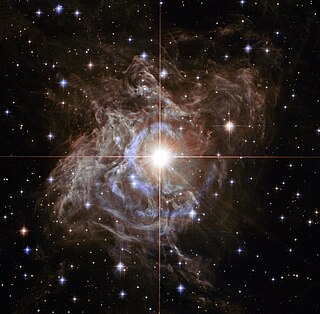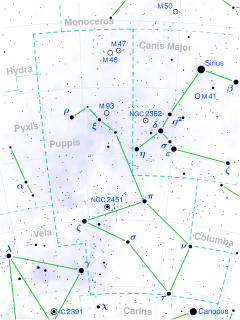
W Sagittarii is a multiple star system star in the constellation Sagittarius, and a Cepheid variable star.

Lambda Ursae Minoris is a star in the constellation Ursa Minor. It is an M-type red giant with an apparent magnitude of +6.38 and is approximately 880 light years from Earth.

RT Aurigae is a yellow supergiant variable star in the constellation Auriga, about 1,500 light years from Earth.

V382 Carinae, also known as x Carinae, is a yellow hypergiant in the constellation Carina. It is a G-type star with a mean apparent magnitude of +3.93, and a variable star of low amplitude.

Omicron1 Centauri is a star in the constellation Centaurus. It is approximately 10,000 light years from Earth.

Omicron2 Centauri is a star in the constellation Centaurus.

RS Puppis is a Cepheid variable star around 6,000 ly away in the constellation of Puppis. It is one of the biggest and brightest known Cepheids in the Milky Way galaxy and has one of the longest periods for this class of star at 41.5 days.

NO Aurigae is a pulsating variable star in the constellation Auriga. It is an unusually-luminous asymptotic giant branch star about 3,500 light years away.

W Virginis is the prototype W Virginis variable, a subclass of the Cepheid variable stars. It is located in the constellation Virgo, and varies between magnitudes 9.46 and 10.75 over a period of approximately 17 days.

V424 Lacertae is a red supergiant variable star in the constellation Lacerta. It is a member of the Lacerta OB1 stellar association.

9 Pegasi is a supergiant star in the constellation Pegasus. Its apparent magnitude is 4.35.

NS Puppis is an irregular variable star in the constellation Puppis. Its apparent magnitude varies between 4.4 and 4.5.

NV Puppis, also known as υ1 Puppis, is a class B2V star in the constellation Puppis. Its apparent magnitude is 4.67 and it is approximately 800 light years away based on parallax.

MX Puppis is a class B1.5IV star in the constellation Puppis. Its apparent magnitude varies irregularly between magnitude 4.6 and 4.9 and it is classified as a Gamma Cassiopeiae variable. It is approximately 930 light years away based on parallax.

KQ Puppis is a spectroscopic binary located about 2,700 light-years from Earth in the constellation Puppis. A red supergiant star and a B-type main-sequence star orbit each other every 27 years. Its apparent magnitude varies between 4.82 and 5.17, making it faintly visible to the naked eye.

10 Persei is a blue supergiant star in the constellation Perseus. Its apparent magnitude is 6.26 although it is slightly variable.

S Vulpeculae is a variable star located in the constellation Vulpecula. A supergiant star, it is around 382 times the diameter of the Sun.

T Persei is a red supergiant located in the constellation Perseus. It varies in brightness between magnitudes 8.3 and 9.7 and is considered to be a member of the Double Cluster.

3 Geminorum is a blue supergiant star in the constellation Gemini. It is a small amplitude pulsating variable and a close double star, with a mean combined apparent visual magnitude of about 5.7.

QY Puppis is a K-type supergiant star in the constellation of Puppis. With a radius of 515 R☉, it is on the smaller end of the largest known stars.


















